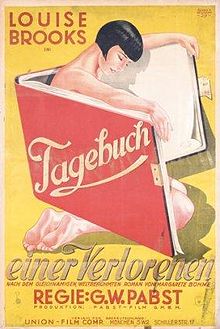Diary of a Lost Girl
Diary of a Lost Girl German Tagebuch einer Verlorenen is a 1929 silent film directed by Georg Wilhelm Pabst and starring the American silent star Louise Brooks. It is shot in black and white, and various versions of the film range from 79 minutes to 116 minutes in length. This was Brooks second and last film with Pabst, and like their prior collaboration 1929s Pandoras Box, it is considered a classic film. The film was based on the controversial and bestselling novel of the same name, Tagebuch einer Verlorenen 1905 by Margarete Bhme. A previous version of the novel, directed in 1918 by Richard Oswald, is now considered a lost film.
Thymians fathers assistant Meinert Fritz Rasp, promises to explain it all to her late that night, but instead takes advantage of her she gives birth to an illegitimate child. Though Thymian refuses to name the babys father, the relatives find out from her diary. They decide that the best solution is for her to marry Meinert. When she refuses because she does not love him, they give the baby to a midwife and send her to a strict reformatory for wayward girls run by a tyrannical woman Valeska Gert and her tall, bald assistant Andrews Engelmann.Meanwhile, Thymians friend, Count Osdorff Andr Roanne, is cast off and left penniless by his rich uncle, also Count Osdorff Arnold Korff, after he proves unsuccessful at every school and trade. Thymian begs her friend to persuade her father to take her back, but Thymians father has married his new housekeeper, Meta Franziska Kinz, and Meta wants no rivals for Roberts affection. Rebelling against the reformatorys rigid discipline, Thymian and her friend Erika Edith Meinhard escape with Osdorffs help. When Thymian goes to see her baby, she is told the child has just died. After despondently wandering the streets, she reunites with Erika, who is working in a small, upperclass brothel. With no skills, Thymian also becomes a prostitute. ........
Source: Wikipedia



